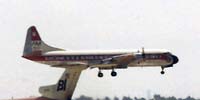| Lockheed | ||||||||||||||||||||||
|
P-3 Orion
|
||||||||||||||||||||||
%20(9.9X4).jpg) |
||||||||||||||||||||||
|
Photo: Robert Deering 10/12/2008 Alliance Airport (AFW) Fort Worth, Texas |
||||||||||||||||||||||
|
Description Four-engine turboprop anti-submarine and maritime surveillance aircraft. Features Originally designed as a land-based, long-range, anti-submarine warfare (ASW) patrol aircraft, the P-3C's mission has evolved in the late 1990s and early 21st century to include surveillance of the battlespace, either at sea or over land. Its long range and long loiter time have proved invaluable assets during Operation Iraqi Freedom as it can view the battlespace and instantaneously provide that information to ground troops, especially U.S. Marines. The P-3C has advanced submarine detection sensors such as directional frequency and ranging (DIFAR) sonobuoys and magnetic anomaly detection (MAD) equipment. The avionics system is integrated by a general purpose digital computer that supports all of the tactical displays, monitors and automatically launches ordnance and provides flight information to the pilots. In addition, the system coordinates navigation information and accepts sensor data inputs for tactical display and storage. The P-3C can carry a mixed payload of weapons internally and on wing pylons. Background The P-3 Orion has been the Navy’s frontline, land-based maritime patrol aircraft since the 1960s. The most capable Orion version is the P-3C, first delivered to the Navy in 1969. The Navy implemented a number of major improvements to the P-3C (Updates I, II, II.5 and III) during its production run. P-3C aircraft communication, navigation, acoustic, non-acoustic and ordnance/weapon systems are still being modernized within several improvement programs to satisfy Navy and joint requirements through the early part of the 21st century. Current modernization programs include installation of a modernized communications suite, Protected Instrument Landing System, IFF Mode S and Required Navigation Performance Area Navigation, GPS, common avionics improvements and modernized cockpit instrumentation. The USQ-78(V) Upgrade Program is improving the USQ-78(V) Single Advanced Signal Processor system Display Control Unit, a programmable system control processor that provides post processing of acoustic data and is the main component of the Update III acoustic configuration. Up to 100 P-3C aircraft are being upgraded to USQ-78B configuration with System Controller (SC) and Acoustic Sub Unit (ASU) Tech Refreshes. In addition, all analog acoustic data recorders are being replaced with digital data recorders. The Critical Obsolescence Program (COP) began in fiscal year 2004 to improve aircraft availability through replacement of obsolete and/or top degrader systems. COP systems include the ARC-230 HF as replacement for the ARC-161, the USQ-130 Data Link as replacement for the ACQ-5, the ASW-60 Autopilot as replacement for the ASW-31, the ASX-6 Multi-Mode Imaging System (MMIS) as replacement for the AAS-36 IRDS and the Telephonics Secure Digital Intercommunications System (SDI) as replacement for the AIC-22 ICS. The Navy has shifted the P-3C’s operational emphasis to the littoral regions and is improving the antisurface warfare (ASUW) capabilities of the P-3C. The antisurface warfare improvement program (AIP) incorporates enhancements in ASUW, over-the-horizon targeting (OTH-T) and command, control, communications and intelligence (C4I), and improves survivability. The AIP program presently includes 72 kits on contract; 69 aircraft have been delivered to the fleet as of September 2006. Upgrades to the armament system include the addition of the AGM-84H/K SLAM-ER missile and Mk54 torpedo capabilities. P-3 mission systems sustainment, necessary to ensure the P-3 remains a viable warfighter until P-8A Poseidon achieves full operational capability (FOC), include acoustic processing upgrades through air acoustic rapid COTS insertion (ARCI) and tech refreshes, mission systems obsolescence management, and the upgrade of P-3 tactical communications and networking through over-the-horizon C4I international marine/maritime satellite (INMARSAT). The ongoing P-3C airframe sustainment program inspects and repairs center and outer wings while reducing Fleet inventory to the mandated 130 aircraft by 2010. The P-3C fleet has experienced significant fatigue degradation over its operational life as quantified through the Service Life Assessment Program (SLAP). The Navy has instituted special structural inspections programs and replacement kits to refurbish aircraft structures to sustain airframe life. The 12 active patrol squadrons (down from 24 in 1991) operate P-3C AIP and Update III configured aircraft. Other P-3 variants still in service include one VP-3A executive transport, four NP-3C and eight NP-3D research and development, testing and evaluation and oceanographic survey aircraft. Numerous countries also fly the P-3 Orion, making it one of the more prevalent Navy aircraft available for foreign military sales and support. |
||||||||||||||||||||||
|
||||||||||||||||||||||
VARIANTS:
|
||||||||||||||||||||||


